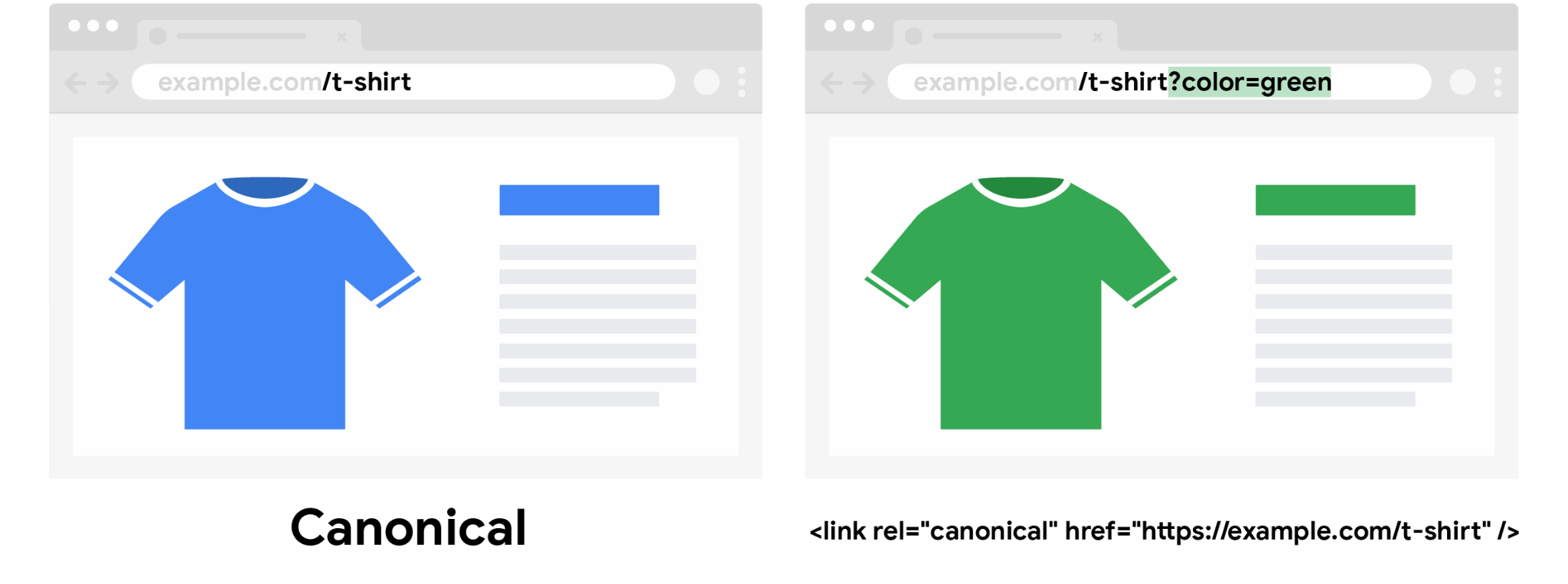Mendesain struktur URL untuk situs e-commerce
URL yang didesain dengan baik dapat membantu Google menemukan dan mengambil halaman web secara lebih efisien di situs e-commerce Anda. Jika Anda mengontrol struktur URL (misalnya, Anda membuat situs sendiri dari awal), panduan ini dapat membantu Anda menentukan struktur URL untuk menghindari masalah pengindeksan yang ditemukan Google di situs e-commerce.
Alasan pentingnya struktur URL
Struktur desain URL yang baik membantu Google meng-crawl dan mengindeks situs Anda, sedangkan struktur URL yang buruk dapat menimbulkan masalah berikut:
-
Konten dapat terlewat jika Googlebot salah menganggap bahwa dua URL akan menampilkan konten yang sama, karena hanya satu URL yang dapat diambil oleh crawler (yang lainnya dihapus sebagai duplikat). Hal ini dapat terjadi jika ID fragmen (seperti
#fragment) digunakan untuk menampilkan konten yang berbeda. Google tidak menggunakan ID fragmen dalam pengindeksan.Contoh:
/product/t-shirt#blackdan/product/t-shirt#whitedianggap sebagai halaman yang sama oleh Google. -
Konten yang sama dapat diambil beberapa kali oleh crawler jika Google menganggap dua URL berbeda meskipun sebenarnya menampilkan halaman yang sama. Hal ini dapat memperlambat crawling situs Anda dan menambah beban pada server web tanpa manfaat apa pun.
Contoh:
/product/black-t-shirtdan/product?sku=1234dapat menampilkan halaman produk yang sama, tetapi Google tidak dapat memastikan hal tersebut hanya dengan melihat URL. -
Crawler mungkin menganggap situs Anda berisi halaman dengan jumlah yang tak terbatas jika URL menyertakan nilai yang terus berubah seperti stempel waktu. Oleh karena itu, Google mungkin memerlukan waktu lebih lama untuk menemukan semua konten yang bermanfaat di situs Anda.
Contoh:
/about?now=12:34amdan/about?now=12:35amdapat diperlakukan sebagai URL yang berbeda oleh Google meskipun kedua URL tersebut menampilkan halaman yang sama.
Lihat Cara Kerja Google Penelusuran dan Cara Crawler Situs Google Mengindeks Situs Anda untuk mengetahui informasi selengkapnya tentang cara Google meng-crawl dan mengindeks situs Anda.
Praktik terbaik desain struktur URL yang baik
Untuk mengoptimalkan cara Google meng-crawl dan mengindeks situs Anda, ikuti praktik terbaik berikut mengenai cara mendesain struktur URL Anda.
Rekomendasi umum untuk URL
- Minimalkan jumlah URL alternatif yang menampilkan konten sama untuk mencegah Google melakukan permintaan yang lebih banyak dari seharusnya ke situs Anda. Google mungkin tidak menyadari bahwa dua URL menampilkan halaman yang sama sampai keduanya diambil.
- Jika teks huruf besar dan kecil di URL diperlakukan sama oleh server web, konversikan semua teks ke format penulisan (huruf besar/kecil) yang sama sehingga Google lebih mudah memastikan bahwa URL merujuk ke halaman yang sama.
- Pastikan setiap halaman dalam hasil dengan penomoran halaman memiliki URL yang unik. Kesalahan URL terbanyak yang kami temui terdapat pada struktur URL penomoran halaman.
-
Tambahkan kata-kata deskriptif di jalur URL. Kata-kata dalam URL dapat membantu Google memahami halaman dengan lebih baik.
Direkomendasikan:
/product/black-t-shirt-with-a-white-collarTidak direkomendasikan:
/product/3243
Rekomendasi parameter kueri URL
Ikuti rekomendasi berikut saat menggunakan parameter kueri untuk membantu Google agar berhasil meng-crawl dan mengindeks situs Anda.
-
Gunakan parameter URL
?key=value, bukan?value, jika memungkinkan. Parameter URL memungkinkan Google Penelusuran memahami struktur, meng-crawl, serta mengindeks situs Anda dengan lebih efisien.Direkomendasikan:
/photo-frames?page=2,/t-shirt?color=greenTidak direkomendasikan:
/photo-frames?2,/t-shirt?green -
Hindari penggunaan parameter yang sama dua kali. Jika tidak, Googlebot dapat mengabaikan salah satu nilai parameter tersebut.
Direkomendasikan:
?type=candy,sweetTidak direkomendasikan:
?type=candy&type=sweet -
Hindari penautan internal ke parameter sementara, seperti ID sesi, kode pelacakan, nilai relatif pengguna (
location=nearby,time=last-week), dan waktu saat ini. Hal ini dapat menyebabkan URL berumur singkat atau memiliki duplikat untuk halaman yang sama. Agar mendapatkan hasil terbaik dari Google Penelusuran, gunakan URL jangka panjang dan persisten.Direkomendasikan:
/t-shirt?location=UKTidak direkomendasikan:
/t-shirt?location=nearby,/t-shirt?current-time=12:02,/t-shirt?session=123123123
Cara Google memahami URL untuk varian produk
Pertimbangan umum di situs e-commerce adalah menentukan cara mendesain struktur URL saat produk tersedia dalam berbagai ukuran atau warna. Setiap kombinasi atribut produk disebut sebagai varian produk. Untuk membantu Google memahami varian produk Anda, pastikan setiap varian dapat diidentifikasi dengan URL terpisah. Sebaiknya gunakan struktur URL berikut untuk URL varian:
-
Segmen jalur, seperti
/t-shirt/green -
Parameter kueri, seperti
/t-shirt?color=green
Untuk informasi selengkapnya, lihat dokumentasi data terstruktur varian produk.
Jika Anda menggunakan parameter kueri opsional untuk mengidentifikasi varian, gunakan URL dengan parameter kueri yang dihilangkan sebagai URL kanonis. Hal ini dapat membantu Google memahami hubungan antara varian produk dengan lebih baik.

Menggunakan URL dalam konten
Untuk membantu Google Penelusuran dan Google Shopping mengidentifikasi produk Anda serta hubungan antara varian produk dengan tepat, ikuti praktik terbaik berikut saat menggunakan URL dalam konten Anda.
-
Gunakan URL yang sama di link internal, file peta situs, dan
tag
<link rel="canonical">. Misalnya, jika Anda ingin menautkan ke halaman pertama, dalam urutan dengan penomoran halaman, menggunakan parameter kueri yang halaman defaultnya adalah halaman pertama, sertakan atau kecualikan?page=1pada URL di seluruh situs Anda secara konsisten. -
Gunakan
tag
<link rel="canonical">yang merujuk ke dirinya sendiri (dengan URL dalam tag mengarah ke halaman saat ini) di semua halaman yang dapat diindeks dan sertakan URL tersebut dalam file sitemap. -
Untuk produk dengan URL unik per varian, sertakan URL produk kanonis di semua halaman
varian menggunakan tag
<link rel="canonical">. Untuk informasi selengkapnya, lihat properti Google Merchant Centercanonical_link. -
Sertakan link secara langsung di halaman menggunakan tag
<a href>; jangan gunakan JavaScript untuk bernavigasi di antara halaman. Googlebot mungkin tidak mendeteksi navigasi dari kode JavaScript. Untuk informasi selengkapnya tentang cara Google memproses JavaScript, lihat Memahami dasar-dasar SEO JavaScript. -
Sertakan teks yang bermakna antara tag
<a href>dan</a>jika memungkinkan, seperti judul produk yang ditautkan. Jangan gunakan frasa umum seperti "klik di sini". -
Hindari penautan ke, atau setidaknya pengindeksan, halaman tanpa konten yang bermanfaat. Jika suatu kategori tidak memiliki item, gunakan
tag
metarobotsnoindex. Jika situs Anda mendeteksi bahwa kategori telah kosong dan otomatis menghapus kategori tersebut dari penelusuran dan penjelajahan di situs, sebaiknya tampilkan kode status HTTP404 (not found)untuk halaman terkait.
Referensi lainnya
Ingin mempelajari lebih lanjut? Lihat referensi berikut:
